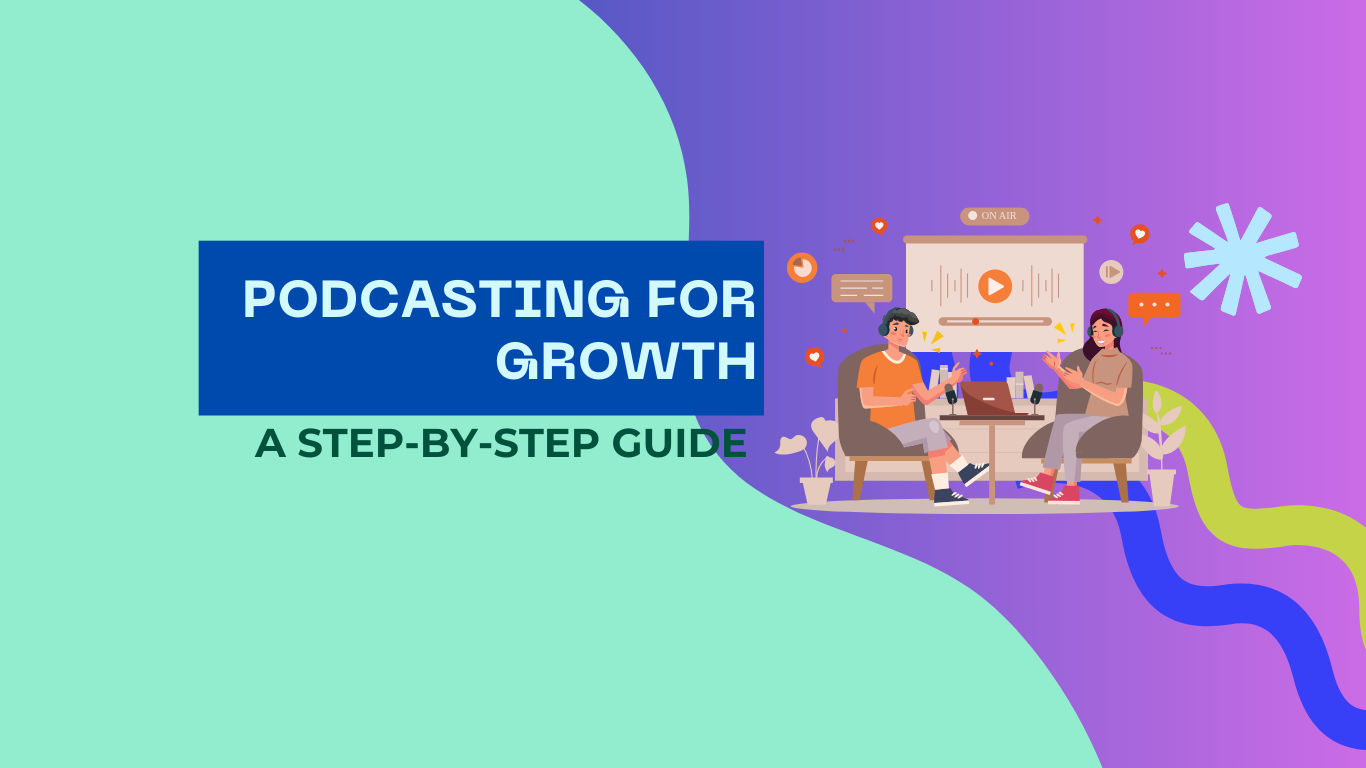Podcasting for Growth: A Step-by-Step Guide

Podcasting has developed into an influential medium for the purposes of sharing stories, creating communities, and expanding businesses. Whether you are an aspiring podcaster just starting out or someone seeking to refine and enhance an existing podcast, this guide provides a thorough roadmap to achieving success in podcasting. Each aspect of the process, from selecting appropriate equipment to determining the most suitable software, is vital for producing a high-quality podcast that truly connects with and resonates with listeners.
Key Takeaways
- Starting a Podcast: Discover the intricate process of conceptualizing your show, defining your target audience, and developing a unique selling proposition that sets you apart in the crowded podcasting landscape.
- Podcast Equipment: Gain a deep understanding of the essential gear required to produce high-quality audio that engages listeners and elevates your content above amateur productions.
- Podcast Production: Immerse yourself in the detailed steps for recording, editing, and publishing your episodes, ensuring a professional and polished final product.
- Podcast Software: Explore the vast array of tools necessary for efficient podcast management and audio enhancement, from recording and editing suites to publishing and analytics platforms.
How to Start a Podcast
Conceptualization
Before you press the record button, the crucial initial step is to thoroughly conceptualize your podcast. This foundational process involves several key tasks that will shape the direction and success of your show:
- Define Your Niche: Select a topic that not only ignites your passion but also has sufficient interest from potential listeners. Consider the intersection of your expertise, current trends, and gaps in the existing podcast market. Your niche should be specific enough to attract a dedicated audience but broad enough to sustain long-term content creation.
- Identify Your Audience: Determine who you're speaking to by creating detailed listener personas. Understanding your audience's demographics, interests, pain points, and listening habits helps tailor content to their specific needs and preferences. This knowledge will inform everything from your content strategy to your marketing efforts.
- Develop Your Format: Decide on the structure of your show. Will you host engaging interviews with industry experts, deliver insightful solo sessions, or present a dynamic mix of content types? Consider the optimal length for each episode based on your content and audience preferences. Additionally, determine the regularity of your posts to establish a consistent release schedule that keeps your audience engaged and coming back for more.
Planning
Once your concept is crystal clear, transition to meticulously planning your episodes to ensure a cohesive and engaging podcast series:
- Create a Content Calendar: Develop a comprehensive plan for your topics and schedule them well in advance. This forward-thinking approach helps maintain a consistent posting rhythm and allows you to align your content with relevant events, holidays, or trends in your niche. A well-structured content calendar also ensures a balanced mix of topics, preventing repetition and keeping your podcast fresh and exciting for listeners.
- Scripting: While some podcasters prefer the authenticity of spontaneity, having a well-crafted script or a detailed outline can significantly enhance the quality of your episodes. A script helps keep your content focused, ensures you cover all essential points, and maintains a dynamic flow throughout the episode. It also serves as a valuable tool for timing your segments and incorporating smooth transitions between topics or segments.
Branding and Launching
Your podcast's branding plays a pivotal role in its recognition and appeal, setting the stage for a successful launch and sustained growth:
- Design a Logo: Create a visually striking and memorable logo that effectively captures the essence of your podcast. The logo should reflect the tone, content, and personality of your show while also being versatile enough to look good across various platforms and sizes. Consider working with a professional designer to ensure your logo stands out in crowded podcast directories.
- Catchy Name and Tagline: Choose a name for your podcast that is not only memorable but also clearly indicates the theme or subject matter of your show. Pair this with a concise, impactful tagline that further elaborates on your podcast's unique value proposition. Together, your name and tagline should instantly communicate what listeners can expect from your show and why they should tune in.
Podcast Equipment
Essential Gear
Investing in quality equipment is crucial for producing clear, professional audio that will set your podcast apart and keep listeners engaged:
- Microphones: A high-quality microphone is the cornerstone of your podcast setup. Options like the Audio-Technica AT2020 or the Rode NT-USB have gained popularity among podcasters for their excellent sound quality and versatility. Consider factors such as your recording environment, budget, and technical requirements when selecting a microphone. USB microphones offer simplicity for beginners, while XLR microphones provide more professional-grade sound and flexibility for advanced setups
- Headphones: Closed-back headphones are the preferred choice for monitoring audio during recording and editing. They provide accurate sound isolation, preventing audio bleed into your microphone and allowing you to catch subtle issues in your recording. Look for comfortable, durable options that offer a flat frequency response for accurate sound reproduction
- Audio Interface: For those seeking higher quality sound and more control over their audio, an audio interface like the Focusrite Scarlett 2i2 is an invaluable addition. These devices help manage audio inputs and outputs, offering improved sound quality and the ability to connect multiple microphones or instruments. They also provide more precise control over gain levels and monitoring options.
Optional Enhancements
While not strictly necessary, these additional items can significantly improve the quality and professionalism of your podcast:
- Pop Filter: This simple accessory reduces plosive sounds like "p" and "b" that can cause unpleasant spikes in your audio. A pop filter helps create a smoother, more polished sound and can save you time in post-production by minimizing the need for extensive editing
- Boom Arm: A boom arm frees up valuable desk space and allows you to position the microphone comfortably and precisely. This flexibility not only improves your recording posture but also helps maintain a consistent distance between you and the microphone, resulting in more uniform audio quality throughout your episodes.
- Acoustic Panels: Enhancing your recording environment with acoustic panels can dramatically improve sound quality by reducing echo and unwanted room reflections. These panels absorb sound waves, creating a more controlled acoustic space that results in cleaner, more professional-sounding recordings. Consider strategically placing panels at key reflection points in your recording area for optimal results.
Podcast Production
Recording
The recording process is where your podcast truly comes to life, and attention to detail here can make a significant difference in the final product:
- Environment: Select and prepare a quiet, non-echoic room to ensure clean audio capture. Pay attention to potential sources of background noise, such as air conditioning units, computer fans, or outside traffic. Consider using rugs, curtains, or the aforementioned acoustic panels to dampen reflections and create a more controlled acoustic environment. The goal is to achieve a dry, clear recording that gives you more flexibility in post-production.
- Technical Setup: Before each recording session, meticulously connect your equipment and perform a thorough test of the audio levels. This includes checking microphone placement, gain settings on your audio interface, and monitoring levels in your recording software. Conduct a brief test recording to ensure all elements are functioning correctly and that your audio quality meets your standards. Proper preparation at this stage can save hours of frustration and potential re-recording later.
Editing
The editing phase is pivotal for transforming your raw recording into a polished, professional podcast episode:
- Editing Software: Utilize powerful tools like Audacity or Adobe Audition to refine your audio. These applications allow you to cut unwanted sections, balance levels between different speakers or segments, and add effects to enhance the overall sound quality. Familiarize yourself with features such as noise reduction, compression, and equalization to address common audio issues and achieve a consistent sound throughout your episode.
Publishing
Getting your podcast out into the world requires careful consideration of hosting and distribution strategies:
- Hosting Platforms: Upload your meticulously crafted episodes to reliable hosting platforms such as Libsyn or Anchor. These services not only store your audio files but also generate the necessary RSS feed and distribute your podcast to major directories like Apple Podcasts, Spotify, and Google Podcasts. Choose a hosting platform that offers robust analytics, ease of use, and scalability to accommodate your podcast's growth.
- Consistency is Key: Establish and maintain a regular release schedule to keep your audience engaged and help boost your podcast's visibility in directories and recommendations. Consistency not only helps build listener habits but also demonstrates your commitment to the podcast, potentially leading to increased subscriber loyalty and organic growth through word-of-mouth recommendations.
Podcast Software
Recording and Editing Tools
Selecting the right software can streamline your workflow and enhance the quality of your podcast:
- Audacity: This free, open-source tool is ideal for beginners looking to edit audio without a significant financial investment. Despite its lack of cost, Audacity offers a robust set of features including multi-track editing, noise reduction, and a variety of audio effects. Its user-friendly interface makes it accessible for those new to audio editing, while still providing enough depth for more advanced users to produce professional-quality podcasts.
- Adobe Audition: For those seeking more advanced features and willing to invest in their podcast production, Adobe Audition offers a comprehensive suite of tools for professional-quality sound editing and production. Its powerful noise reduction capabilities, multi-track editing, and integration with other Adobe Creative Cloud applications make it a favorite among seasoned podcasters and audio professionals. Audition's spectral frequency display and batch processing features can significantly speed up your editing workflow for more complex productions.
Management and Enhancement
Specialized podcast production tools can automate many aspects of post-production, saving time and ensuring consistency:
- Alitu: This web-based platform helps automate various aspects of post-production, including audio leveling, noise reduction, and publishing. Alitu's user-friendly interface guides you through the entire process from uploading your raw audio to publishing the final episode. Its automated processing can be a game-changer for podcasters looking to maintain high quality while reducing the time spent on technical aspects of production.
- Descript: Offering an innovative approach to podcast editing, Descript combines recording, editing, and transcription services with unique features like the ability to remove filler words automatically. Its text-based editing feature allows you to edit your podcast as easily as you would edit a document, making it particularly useful for content-driven shows that require precise editing of interviews or scripted content. Descript's collaborative features also make it an excellent choice for podcast teams working remotely.
Conclusion
Podcasting represents an exciting and dynamic medium with immense potential for personal expression, community building, and professional growth. By meticulously planning your podcast concept, investing in the right combination of equipment, and leveraging effective production and software tools, you can create a compelling audio experience that not only captivates your audience but also stands out in the increasingly crowded podcasting landscape. Remember that success in podcasting often comes from a blend of quality content, consistent delivery, and genuine engagement with your listeners. As you embark on or continue your podcasting journey, stay open to learning, be willing to adapt to feedback, and most importantly, enjoy the process of sharing your voice with the world.




.png)
.png)


.png)
